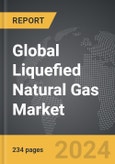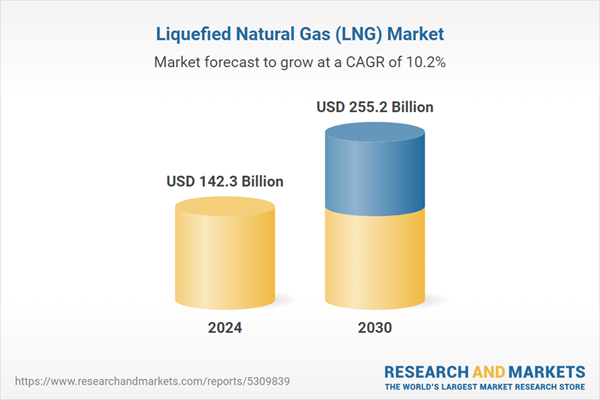The global market for Liquefied Natural Gas (LNG) was valued at US$142.3 Billion in 2024 and is projected to reach US$255.2 Billion by 2030, growing at a CAGR of 10.2% from 2024 to 2030. This comprehensive report provides an in-depth analysis of market trends, drivers, and forecasts, helping you make informed business decisions. The report includes the most recent global tariff developments and how they impact the Liquefied Natural Gas (LNG) market.
Segments: Application (Power Generation, Transportation Fuel, Other Applications).
Geographic Regions/Countries: World; United States; Canada; Japan; China; Europe (France; Germany; Italy; United Kingdom; Spain; Russia; and Rest of Europe); Asia-Pacific (Australia; India; South Korea; and Rest of Asia-Pacific); Latin America (Argentina; Brazil; Mexico; and Rest of Latin America); Middle East (Iran; Israel; Saudi Arabia; United Arab Emirates; and Rest of Middle East); and Africa.
The analysts continuously track trade developments worldwide, drawing insights from leading global economists and over 200 industry and policy institutions, including think tanks, trade organizations, and national economic advisory bodies. This intelligence is integrated into forecasting models to provide timely, data-driven analysis of emerging risks and opportunities.
Global Liquefied Natural Gas (LNG) Market - Key Trends & Drivers Summarized
How Is the Global Energy Transition Impacting the LNG Market?
The global energy transition towards cleaner and more sustainable energy sources is significantly impacting the liquefied natural gas (LNG) market. As countries aim to reduce their carbon emissions and phase out coal and oil, LNG is increasingly seen as a critical 'bridge fuel' that offers a lower-carbon alternative to traditional fossil fuels. Natural gas, when liquefied, can be easily transported and stored, making it a flexible and reliable option for meeting growing energy demands. This shift is particularly pronounced in regions such as Asia-Pacific and Europe, where governments are actively promoting the use of LNG to support decarbonization efforts. As part of this energy transition, investments in LNG infrastructure, including liquefaction plants, storage facilities, and regasification terminals, are accelerating, further boosting the market's expansion.Why Are Technological Innovations Enhancing the Efficiency of LNG Operations?
Technological innovations are playing a key role in enhancing the efficiency of LNG operations across the supply chain. Advancements in liquefaction and regasification technologies are helping to reduce energy consumption and minimize methane leakage during production, transportation, and distribution processes. The development of floating LNG (FLNG) platforms is providing new opportunities for extracting and processing natural gas from offshore fields, reducing the need for extensive onshore infrastructure. Additionally, digitalization and automation in LNG plants are improving operational efficiency by optimizing asset performance, predictive maintenance, and real-time monitoring. These technological advancements are enabling LNG producers to reduce costs and improve the overall sustainability of LNG production, making it a more attractive option for energy markets worldwide.How Are Geopolitical Factors and Trade Dynamics Shaping the LNG Market?
Geopolitical factors and trade dynamics are playing a crucial role in shaping the LNG market, as global energy security becomes a key concern for both producers and consumers. The diversification of energy sources is driving demand for LNG as countries seek to reduce their reliance on specific regions for energy imports, such as Europe’s shift away from Russian gas. Trade agreements and the expansion of LNG export capacities in countries like the United States, Qatar, and Australia are contributing to the global supply of LNG, helping to stabilize the market. However, fluctuations in global natural gas prices, trade tensions, and shifts in demand from key importing countries, such as China and Japan, continue to create volatility in the market. This interplay of geopolitical and trade factors is influencing the strategic decisions of both LNG producers and consumers.How Is the Growth in the Liquefied Natural Gas (LNG) Market Driven by Several Factors?
The growth in the liquefied natural gas (LNG) market is driven by several factors, including the global shift towards cleaner energy sources, technological innovations in LNG production, and evolving geopolitical and trade dynamics. The increasing focus on reducing carbon emissions and transitioning away from coal and oil is bolstering demand for LNG as a lower-emission fuel. Technological advancements in liquefaction, floating LNG platforms, and digital automation are improving the efficiency and sustainability of LNG operations, making it a more viable energy source. Geopolitical factors, such as energy security concerns and diversification of energy imports, are also playing a critical role in shaping the global LNG trade. Furthermore, growing investments in LNG infrastructure and expanding export capacities in major producing countries are contributing to the market’s robust growth trajectory.Report Scope
The report analyzes the Liquefied Natural Gas (LNG) market, presented in terms of units. The analysis covers the key segments and geographic regions outlined below.Segments: Application (Power Generation, Transportation Fuel, Other Applications).
Geographic Regions/Countries: World; United States; Canada; Japan; China; Europe (France; Germany; Italy; United Kingdom; Spain; Russia; and Rest of Europe); Asia-Pacific (Australia; India; South Korea; and Rest of Asia-Pacific); Latin America (Argentina; Brazil; Mexico; and Rest of Latin America); Middle East (Iran; Israel; Saudi Arabia; United Arab Emirates; and Rest of Middle East); and Africa.
Key Insights:
- Market Growth: Understand the significant growth trajectory of the Power generation segment, which is expected to reach US$131.5 Billion by 2030 with a CAGR of a 11.0%. The Transportation Fuel segment is also set to grow at 10.2% CAGR over the analysis period.
- Regional Analysis: Gain insights into the U.S. market, valued at $36.7 Billion in 2024, and China, forecasted to grow at an impressive 16.1% CAGR to reach $70.0 Billion by 2030. Discover growth trends in other key regions, including Japan, Canada, Germany, and the Asia-Pacific.
Why You Should Buy This Report:
- Detailed Market Analysis: Access a thorough analysis of the Global Liquefied Natural Gas (LNG) Market, covering all major geographic regions and market segments.
- Competitive Insights: Get an overview of the competitive landscape, including the market presence of major players across different geographies.
- Future Trends and Drivers: Understand the key trends and drivers shaping the future of the Global Liquefied Natural Gas (LNG) Market.
- Actionable Insights: Benefit from actionable insights that can help you identify new revenue opportunities and make strategic business decisions.
Key Questions Answered:
- How is the Global Liquefied Natural Gas (LNG) Market expected to evolve by 2030?
- What are the main drivers and restraints affecting the market?
- Which market segments will grow the most over the forecast period?
- How will market shares for different regions and segments change by 2030?
- Who are the leading players in the market, and what are their prospects?
Report Features:
- Comprehensive Market Data: Independent analysis of annual sales and market forecasts in US$ Million from 2024 to 2030.
- In-Depth Regional Analysis: Detailed insights into key markets, including the U.S., China, Japan, Canada, Europe, Asia-Pacific, Latin America, Middle East, and Africa.
- Company Profiles: Coverage of players such as ANGOLA LNG MARKETING LTD, Applied LNG, Atlantic LNG, Australia Pacific LNG Pty Limited, BNG Fuel and more.
- Complimentary Updates: Receive free report updates for one year to keep you informed of the latest market developments.
Some of the 22 companies featured in this Liquefied Natural Gas (LNG) market report include:
- ANGOLA LNG MARKETING LTD
- Applied LNG
- Atlantic LNG
- Australia Pacific LNG Pty Limited
- BNG Fuel
- Center for Liquefied Natural Gas
- Centrality Investments Limited
- Cheniere Energy Inc
- Chiyoda International Corporation
- Clean Energy Fuels Australia
Tariff Impact Analysis: Key Insights for 2025
Global tariff negotiations across 180+ countries are reshaping supply chains, costs, and competitiveness. This report reflects the latest developments as of April 2025 and incorporates forward-looking insights into the market outlook.The analysts continuously track trade developments worldwide, drawing insights from leading global economists and over 200 industry and policy institutions, including think tanks, trade organizations, and national economic advisory bodies. This intelligence is integrated into forecasting models to provide timely, data-driven analysis of emerging risks and opportunities.
What’s Included in This Edition:
- Tariff-adjusted market forecasts by region and segment
- Analysis of cost and supply chain implications by sourcing and trade exposure
- Strategic insights into geographic shifts
Buyers receive a free July 2025 update with:
- Finalized tariff impacts and new trade agreement effects
- Updated projections reflecting global sourcing and cost shifts
- Expanded country-specific coverage across the industry
Table of Contents
I. METHODOLOGYII. EXECUTIVE SUMMARY2. FOCUS ON SELECT PLAYERSIII. MARKET ANALYSISIV. COMPETITION
1. MARKET OVERVIEW
3. MARKET TRENDS & DRIVERS
4. GLOBAL MARKET PERSPECTIVE
UNITED STATES
CANADA
JAPAN
CHINA
EUROPE
FRANCE
GERMANY
ITALY
UNITED KINGDOM
SPAIN
RUSSIA
REST OF EUROPE
ASIA-PACIFIC
AUSTRALIA
INDIA
SOUTH KOREA
REST OF ASIA-PACIFIC
LATIN AMERICA
ARGENTINA
BRAZIL
MEXICO
REST OF LATIN AMERICA
MIDDLE EAST
IRAN
ISRAEL
SAUDI ARABIA
UNITED ARAB EMIRATES
REST OF MIDDLE EAST
AFRICA
Companies Mentioned (Partial List)
A selection of companies mentioned in this report includes, but is not limited to:
- ANGOLA LNG MARKETING LTD
- Applied LNG
- Atlantic LNG
- Australia Pacific LNG Pty Limited
- BNG Fuel
- Center for Liquefied Natural Gas
- Centrality Investments Limited
- Cheniere Energy Inc
- Chiyoda International Corporation
- Clean Energy Fuels Australia
Table Information
| Report Attribute | Details |
|---|---|
| No. of Pages | 234 |
| Published | April 2025 |
| Forecast Period | 2024 - 2030 |
| Estimated Market Value ( USD | $ 142.3 Billion |
| Forecasted Market Value ( USD | $ 255.2 Billion |
| Compound Annual Growth Rate | 10.2% |
| Regions Covered | Global |









